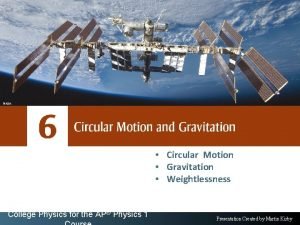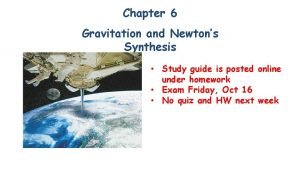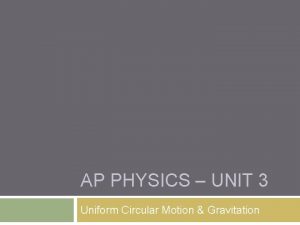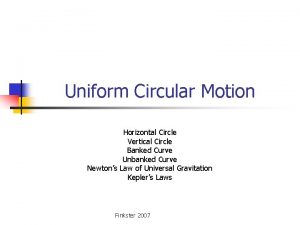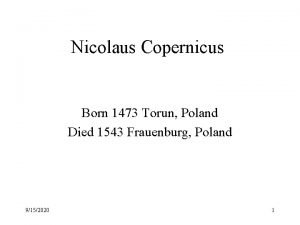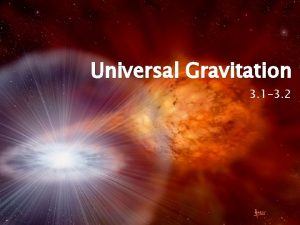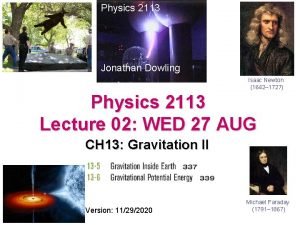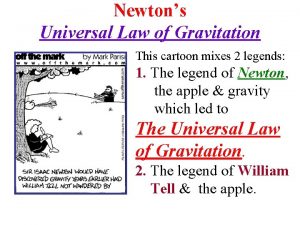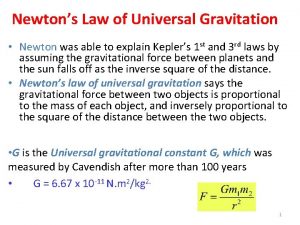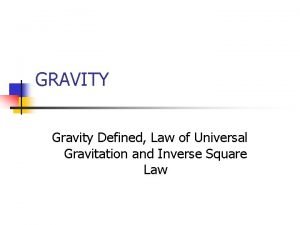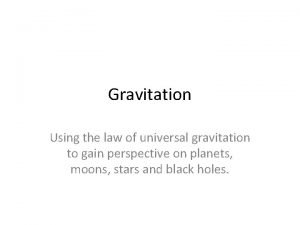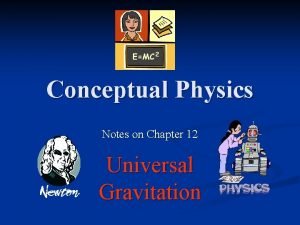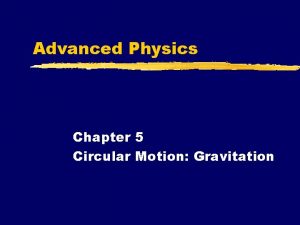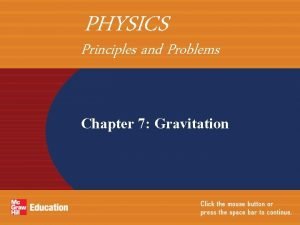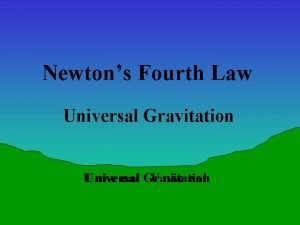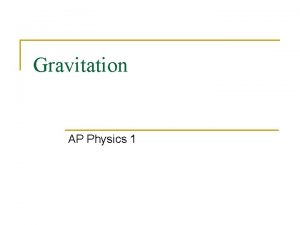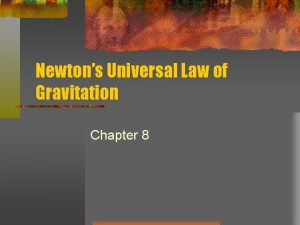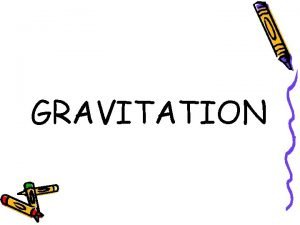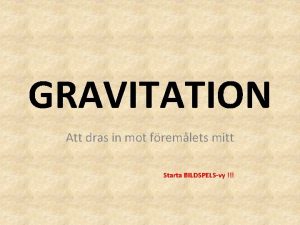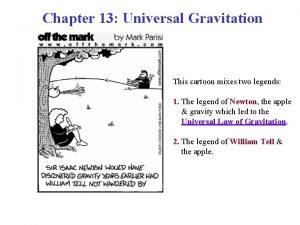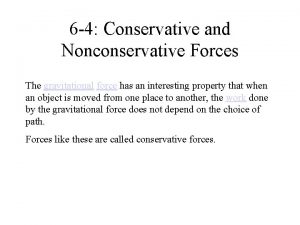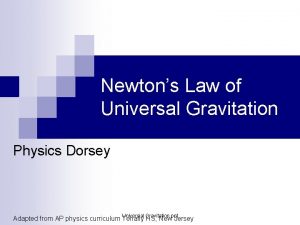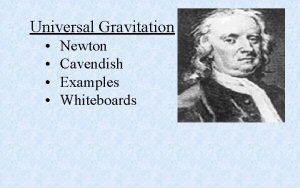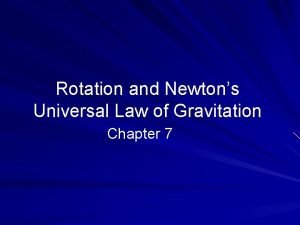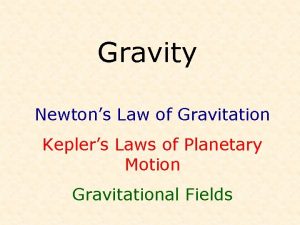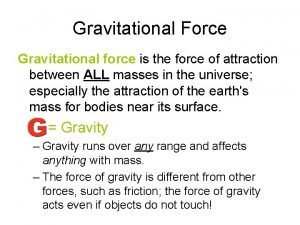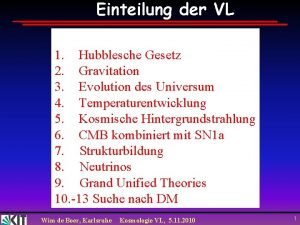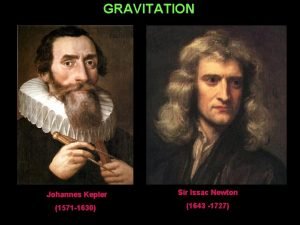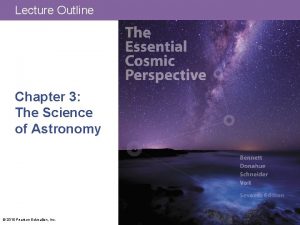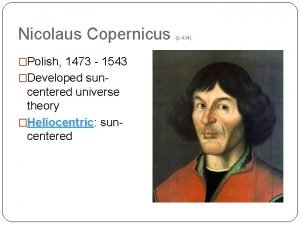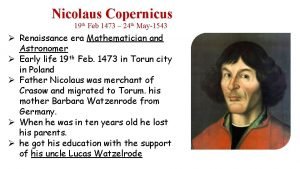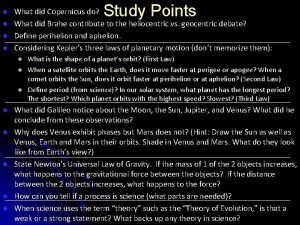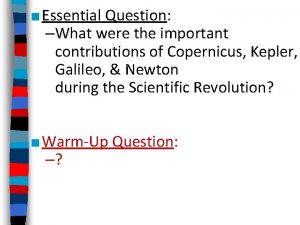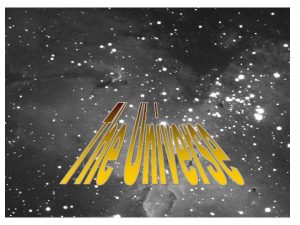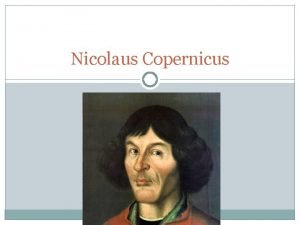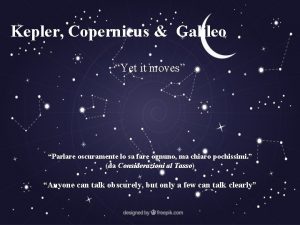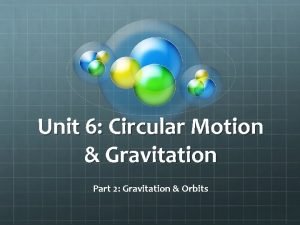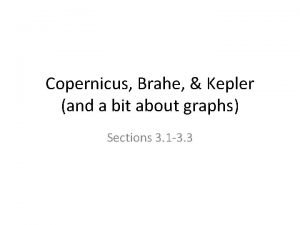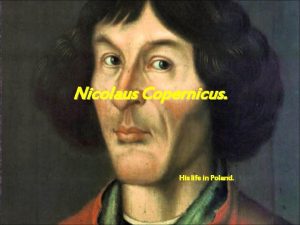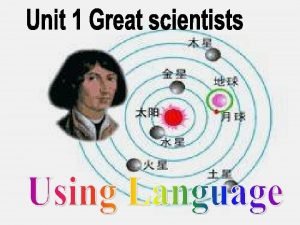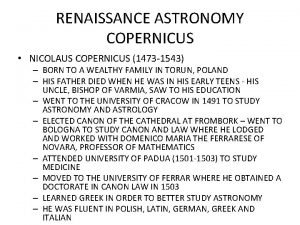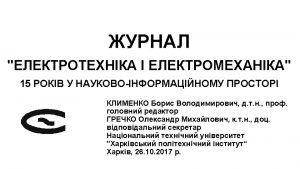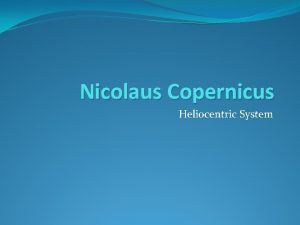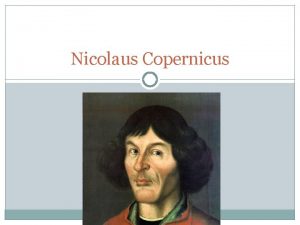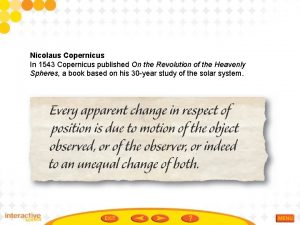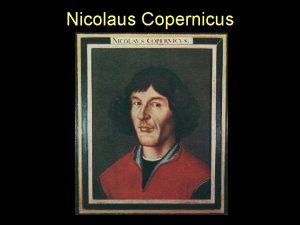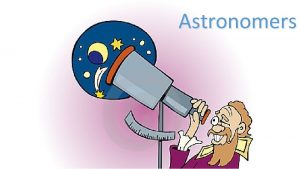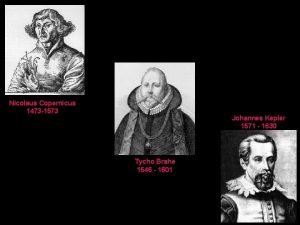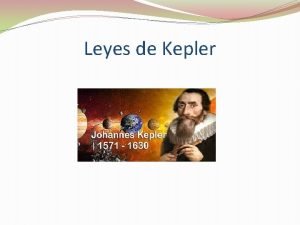Gravitation Part I Copernicus Galileo and Kepler Ch







































- Slides: 39

Gravitation Part I. Copernicus, Galileo, and Kepler (Ch 4) 1

Celestial motions • The stars: • Uniform daily motion around the celestial poles (rising and setting). • The Sun: • Daily motion around the celestial poles. • Eastward drift on the celestial sphere along the ecliptic over a year, a little faster in winter, slower in summer. N-S drift over the seasons. • The Moon: • Daily motion around the celestial poles. • Eastward motion on the celestial sphere near the ecliptic over a month. 2

Celestial motions • The planets: • Daily motions around the celestial poles. • Generally eastward motion on the celestial sphere near the ecliptic at different speeds for each planet. • Occasional westward "retrograde" motions. • Planets change in brightness and angular size. Any successful description of the Solar System must explain all these facts! 3

The planets move across the celestial sphere near the ecliptic, but sometimes they stop, go backwards for a while, then continue on as normal! This is retrograde motion. Path of Mars in 2005 – 2006. Now we understand why this occurs 4

The appearance of the celestial sphere gives the impression that the Earth is the “center of the Universe”, and everything moves around us. This was the accepted model passed down from Greek scholars, and other cultures, and is known as the “geocentric” model. 5

Ancient Greeks – First attempts at reasoning • • • Thales (c 624 - c 546 BC): Natural explanations Anaximander (c 611 - c 546 BC): First “cosmology” Pythagoras (c 560 - c 480 BC): Moon, Earth spherical Aristotle (384 - 322 BC): Earth spherical Aristarchus (310? – 230? BC): Relative sizes of Sun, Moon, Earth orbits Sun, other stars much further away • Eratosthenes (c 276 - c 192 BC): Earth’s diameter • Hipparchus (c 165 - c 127 BC): precession, epicycles • Ptolemy (c 90 – c 168 AD): most complex epicyclic model 6

Aristotelian assumptions • Earth is a sphere, fixed at center of Universe • If Earth were moving, we would see an annual parallax • Natural state of motion of Heavens is continuous uniform circular motion 7

The motion of the planets is not so straightforward! Retrograde motion had to be explained. The accepted geocentric model, fine-tuned in the second century A. D. , was called the Ptolemaic system. It required complex circles-on-circles to explain retrograde motion. 8

Ptolemaic system required “deferents” and “epicycles” to explain planetary motion. 9

(relative to stars) 10

11

Ptolemy’s geocentric model 12

Ptolemaic system explained the motions and could predict them, but was messy, and got messier as observations improved. System was used for over a thousand years (even taught at Harvard in its early days!). "If the Lord Almighty had consulted me before embarking upon the Creation, I should have recommended something simpler. “ Alfonso X El Sabio "The Wise", of Castile (1221 -1284) upon being instructed in the Ptolemaic system. 13

Nicolaus Copernicus (1473 – 1543) rediscovered Aristarchus’ idea and developed the first comprehensive heliocentric (= Sun-centered) model. Had access to data 14 from Alfonso X.

Copernicus’ heliocentric model: • All planets, Earth included, revolve around the Sun. • Planets farther from Sun take longer to complete orbit. Orbits are circular. • Orbits of Earth and planets are nearly in the same plane. • The Earth rotates on its axis once a day. This explains diurnal motions. • Stars are much further away – they show no epicycles. • Copernicus wasn’t convinced it was correct, but liked its simplicity! 15

Retrograde motion is explained (in principle)! The inner planet (Earth) moves faster than the outer one (Mars), creating the apparent motion. Another effect of parallax. 16

Copernicus noticed Mercury and Venus are never far in angle from the Sun. They are the inferior planets, which have orbits smaller than Earth's. The others, which can get to 180° from the Sun, are the superior planets, with orbits larger than Earth's. He was able to correctly order them (Mars, Jupiter, Saturn). Stars much further away because no apparent motion except due to Earth’s rotation. 17

The angle between the Sun and a planet viewed from Earth is the planet’s elongation. When an inferior planet is at inferior conjunction, it is between us and the Sun. At superior conjunction, the inferior planet is on the opposite side of the Sun. A superior planet at conjunction is behind the Sun. A superior planet at opposition is in the part of the sky opposite the Sun. 18

The dates show when Mars is at opposition - these are the best times to observe Mars. animation 19

Copernicus could now calculate the size of the orbits of the inferior planets relative to Earth’s orbit: At greatest elongation, line of sight from Earth to Venus makes an angle of about e=46° to line of sight from Earth to Sun. What is distance from Sun to Venus in terms of e and a? However, length of AU not yet measured. 20

De revolutionibus orbium coelestium On the revolutions of the celestial spheres, 1543 Not immediately accepted! Wasn’t significantly better than Ptolemaic system for calculating planetary positions, and still needed some epicycles (because he insisted on uniform circular motions – Kepler would show this to be wrong). 21

Objections to Copernicus' model • Religious • No observational evidence of Earth’s motion in form of stellar parallaxes • No better than Ptolemaic model for predicting positions Copernicus didn’t publicly advocate his model. But Galileo did, laying the path to its acceptance. 22

Galileo Galilei (1564 – 1642). Didn’t invent the telescope (Dutch invention), but was first to use it for astronomy. 23

Galileo saw spots on the Sun. Saw them rotate, inferred Sun does. He also saw mountains and craters on the Moon Galileo also discovered 4 bodies which clearly didn’t revolve around the Earth – the “Galilean satellites” of Jupiter. 24

Galileo’s other observations: Venus goes through phases, and the angular size changes (and these are related). The Ptolemaic model can’t explain this. 25

In the Ptolemaic model, Venus would always be less than half illuminated. 26

Phases are easy to understand in heliocentric picture. Note the relation between angular size and phase. Animation 27

28

Impact of Galileo's observations • Galileo went public and became well known • Skeptics claimed that the telescope was lying… • …but, many people got their own telescopes (including Kepler), they could see for themselves • The Copernican system started to be taken seriously • Galileo’s ideas were declared heretical by the Church. • He was forced to recant his ideas, and spent his last years under house arrest (but the ideas were out anyway!) Copernicus’ model still had inadequacies… 29

Tycho Brahe (1546 -1601) Made two huge contributions: 1. 2. He made very careful observations of planetary positions over time. He hired Johannes Kepler as his assistant. 30

Johannes Kepler (1571 – 1630) analyzed Tycho’s accurate planetary position data. 31

Kepler determined that planets move on elliptical orbits. 32

The semi-major axis of an ellipse is half of the major axis, and is usually denoted “a”. The eccentricity of the ellipse measures how squashed it is. If the distance from the center of the ellipse to a focus is “c”, then a c 33 Eccentricity also relates major and minor axes:

Kepler’s first law: The orbit of a planet about the Sun is an ellipse with the Sun at one focus. The semi-major axis of a planet’s orbit is also the average distance between the planet and the Sun (will not prove, and actually depends on definition of “average”). Examples: planetary orbit with smallest eccentricity is Venus (e = 0. 007). Largest is Mercury (e = 0. 206). For Earth, e = 0. 017. Knowing a and e specifies ellipse size and shape. 34

Kepler’s second law: a line joining a planet and the Sun sweeps out equal areas in equal intervals of time. In other words, a planet moves fastest when it is nearest the Sun, and slowest when it is farthest away from the Sun. Perihelion = point in orbit closest to the Sun. Aphelion = point in orbit farthest from the Sun. Kepler’s Laws applet 35

Time it takes planet to go from point A to point B is the same as it takes to go from point C to point D. 36

(Advanced note: this law is a direct consequence of conservation of angular momentum) We can calculate the distance from a planet to the Sun at perihelion and aphelion. a c Dperi = a – c = a – ae = a(1 – e) Dap = a + c =a +ae = a(1 + e) 37

Kepler’s third law: The square of the sidereal period of a planet is directly proportional to the cube of the semi-major axis of the orbit. • The larger the planet’s orbit, the longer it takes the planet to go around the Sun. • P 2 a 3 • P 2 = a 3, when P is measured in years, and a is measured in AU • Note: AU still not measured. But law describes relative orbit sizes Kepler’s Laws applet 38

Example: For Earth, P = 1 year, a = 1 AU, so P 2 = 1 = a 3 More interesting example: For Venus, we know a = 0. 72 AU What is P? P 2 = a 3, so = 0. 61 years. Kepler had no idea why these laws worked. That took Newton! 39
 Johannes kepler galileo galilei
Johannes kepler galileo galilei Martin kirby physics
Martin kirby physics Gravitation and newton's synthesis
Gravitation and newton's synthesis Ap physics unit 3 circular motion and gravitation
Ap physics unit 3 circular motion and gravitation Vertical circle and horizontal circle
Vertical circle and horizontal circle When was copernicus born and died
When was copernicus born and died Explain newton’s universal law of attraction/gravitation.
Explain newton’s universal law of attraction/gravitation. Gauss theorem
Gauss theorem Newton's third law cartoon
Newton's third law cartoon The laws of gravity
The laws of gravity Newton's law of gravitation
Newton's law of gravitation Kinetic energy and gravity
Kinetic energy and gravity Universal gravitation law
Universal gravitation law Minimum velocity
Minimum velocity Universal gravitation law
Universal gravitation law Conceptual physics chapter 13 universal gravitation
Conceptual physics chapter 13 universal gravitation Chapter 5 circular motion gravitation
Chapter 5 circular motion gravitation Universal law of gravitation calculator
Universal law of gravitation calculator Chapter 7 study guide gravitation
Chapter 7 study guide gravitation Newton's fourth law of gravitation
Newton's fourth law of gravitation Newton's universal law of gravitation ap physics 1
Newton's universal law of gravitation ap physics 1 Newton's universal law of gravitation simplified
Newton's universal law of gravitation simplified Is gravity a natural phenomenon
Is gravity a natural phenomenon Gravitation enhet
Gravitation enhet Cartoon law of universal gravitation
Cartoon law of universal gravitation Is gravitational force conservative or non-conservative why
Is gravitational force conservative or non-conservative why Law of universal gravitation ppt
Law of universal gravitation ppt Law of universal gravitation kid definition
Law of universal gravitation kid definition Universal law of gravitation
Universal law of gravitation Gravitation
Gravitation Effect of gravitational force
Effect of gravitational force Gravitation scheinkraft
Gravitation scheinkraft Kepler and newton
Kepler and newton With stars
With stars Nicolaus copernicus theory
Nicolaus copernicus theory Nicolaus copernicus contribution
Nicolaus copernicus contribution Copernican revolution summary
Copernican revolution summary Who proved copernicus theory
Who proved copernicus theory Nickolas copernicus
Nickolas copernicus Nicolaus copernicus hobbies
Nicolaus copernicus hobbies

